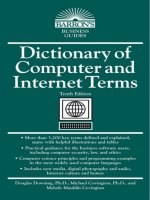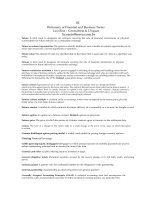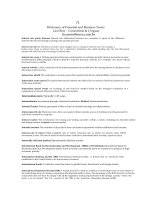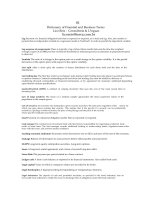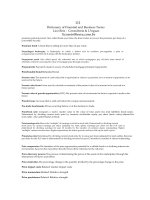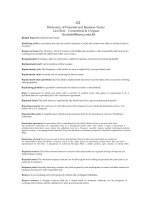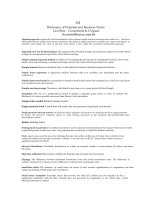dictionary of computer and internet terms (2009) - (malestrom)
Bạn đang xem bản rút gọn của tài liệu. Xem và tải ngay bản đầy đủ của tài liệu tại đây (9.16 MB, 561 trang )
Dictionary of
Computer and
Internet Terms
Tenth Edition
Douglas A. Downing, Ph.D.
School of Business and Economics
Seattle Pacific University
Michael A. Covington, Ph.D.
Artificial Intelligence Center
The University of Georgia
Melody Mauldin Covington
Covington Innovations
Athens, Georgia
Catherine Anne Covington
Covington Innovations
Athens, Georgia
With the assistance of
Sharon Covington
7_4105_DO_CompInternetTerms_FM 12/29/08 10:15 AM Page i
© Copyright 2009, 2006, 2003, 2000, 1998, 1996, 1995, 1992, 1989,
and 1986 by Barron’s Educational Series, Inc.
All rights reserved.
No part of this book may be reproduced or distributed in
any form or by any means without the written permission
of the copyright owner.
All inquiries should be addressed to:
Barron’s Educational Series, Inc.
250 Wireless Boulevard
Hauppauge, NY 11788
www.barronseduc.com
ISBN-13: 978-0-7641-4105-8
ISBN-10: 0-7641-4105-8
Library of Congress Catalog Card No. 2008044365
Library of Congress Cataloging-in-Publication Data
Downing, Douglas.
Dictionary of computer and Internet terms / Douglas A. Downing,
Michael A. Covington, Melody Mauldin Covington. — 10th ed.
p. cm.
ISBN 978-0-7641-4105-8
1. Computers—Dictionaries. 2. Internet—Dictionaries. I. Covington,
Michael A., 1957– II. Covington, Melody Mauldin. III. Title.
QA76.15.D667 2009
004.03—dc22 2008044365
PRINTED IN CHINA
987654321
ABOUT THE AUTHORS
Douglas Downing teaches economics and quantitative methods at the School of
Business and Economics at Seattle Pacific University. He is the author of several
books in both Barron’s Easy Way and Business Review series. He is also the author
of Java Programming the Easy Way and Dictionary of Mathematics Terms, published
by Barron’s Educational Series, Inc. He holds the Ph.D. degree in economics from
Yale University.
Michael Covington is Associate Director of the Artificial Intelligence Institute at
the University of Georgia. He is the author of several books and over 250 magazine
articles. He holds the Ph.D. degree in linguistics from Yale University.
Melody Mauldin Covington is a graphic designer living in Athens, Georgia. She
is the author of Dictionary of Desktop Publishing (published by Barron’s).
Catherine Anne Covington is a student at the Lamar Dodd School of Art
(University of Georgia).
Sharon Covington is a student at Emory University.
7_4105_DO_CompInternetTerms_FM 12/29/08 10:15 AM Page ii
CONTENTS
About the Authors ii
To the Reader iv
Dictionary of Computer and Internet Terms 1
Numbers 1
Greek Letters 5
A 7
B 38
C 71
D 124
E 159
F 185
G 211
H 223
I 242
J 264
K 272
L 276
M 296
N 322
O 336
P 349
Q 389
R 392
S 421
T 468
U 498
V 510
W 521
X 538
Y 543
Z 545
Visual Dictionary of Characters and Symbols 547
Country Codes for Top-Level Domains 552
7_4105_DO_CompInternetTerms_FM 12/29/08 10:15 AM Page iii
TO THE READER
Computers are no longer just for specialists. Today, computing is not just a
profession and a hobby; it is also a tool used in virtually all human activities.
That’s why we’ve compiled this book of background knowledge. Its pur-
pose is to tell you the things other people think you already know.
We design this book to have a convenient size so it can be easily carried
around. In compiling a book this size, we have had to be selective. The
quickest way to identify a word that you can’t find in a book is probably to
do a web search (see SEARCH ENGINE). Also, some terms are almost always
abbreviated, and in that case you should look for the abbreviation rather
than the full term.
Much has changed since the first edition of this book was published
more than twenty years ago. New terms are being invented every day. We
regularly update the book, and this edition contains new entries on a vari-
ety of topics including Windows Vista and Mac OS X. We’ve also cut out
material that was showing its age.
Terms are marked slang or humorous if they are seldom used in serious
writing. They are marked as jargon if, in our estimation, they are somewhat
pretentious new names for old concepts and are not likely to endure. We
provide occasional Usage notes to explain grammar, spelling, and proper
use of words, such as the exact difference between disc and disk.
Throughout, we use SMALL CAPITALS to mark important words that are
defined elsewhere in this book. By following cross-references, you can
quickly find many entries that pertain to whatever interests you. Here are
some entries you may wish to start with to learn about particular topics:
• Internet culture: CHAT ROOM
• right and wrong: COMPUTER ETHICS
• safe computing: COMPUTER SECURITY
• solving exceptionally difficult problems: ARTIFICIAL INTELLIGENCE
• productively using computers in business and daily life: APPLICATION
PROGRAM
• listening to music: DIGITAL MUSIC
• taking pictures: DIGITAL CAMERA
• creating web pages: HTML
• writing computer programs: PROGRAMMING LANGUAGE
• software that controls a computer: OPERATING SYSTEM
• how a computer works: COMPUTER ARCHITECTURE
• networking and the Internet: INTERNET
• connecting computers wirelessly: WIRELESS COMMUNICATION
• electronic components: TRANSISTOR
iv
7_4105_DO_CompInternetTerms_FM 12/29/08 10:15 AM Page iv
Be sure to notice the visual dictionary of symbols at the end of the book.
If you don’t know what ∑ or ≈ or • is called, don’t worry; you can look it
up there.
All four of us want to thank The University of Georgia and Seattle
Pacific University for access to facilities and for accommodating us as we
worked on the project. We also want to thank Robert Downing for help with
1960s data processing terminology; Sharon Covington for help with current
Internet culture; and Brantley Coile of Coraid, Inc., for permission to adapt
material from Coraid’s glossary of networking and data storage.
Many of the words used in this book are registered trademarks. We have
made no attempt to determine or report their legal status. For further infor-
mation about any product name, consult the manufacturer’s literature.
v TO THE READER
7_4105_DO_CompInternetTerms_FM 12/29/08 10:15 AM Page v
7_4105_DO_CompInternetTerms_FM 12/29/08 10:15 AM Page vi
NUMBERS
1-2-3 see LOTUS 1-2-3.
3Com a leading producer of networking hardware, mainly focusing on res-
idential and small to medium businesses. In recent years the company
has sharpened its focus in this area by acquiring U.S. Robotics but sell-
ing off Palm (see PALM). Their web address is www.3com.com.
3D see THREE-DIMENSIONAL GRAPHICS.
4
××
, 8
××
, 16
××
. . . 64
××
(etc.) describing a CD or DVD drive, able to transfer
data at 4, 8, 16 (etc.) times the speed of normal audio or video. For
example, a 16× CD-R drive can record a full CD, equivalent to about an
hour of audio, in about four minutes.
5.1 a format of SURROUND SOUND with five speakers that transmit the full
audio spectrum and one that transmits only bass. The five full-range
speakers are positioned as front left, center, and right, and rear left and
right. The bass speaker, or SUBWOOFER, is usually placed in front. See
Fig. 253, p. 464. Compare 6.1, 7.1.
6.1 a format of SURROUND SOUND with six full-range speakers in the left
front, center front, right front, left, right, and rear center positions, plus
a SUBWOOFER for additional bass. Compare 5.1.
7-layer model see DATA COMMUNICATION.
7.1 a format of SURROUND SOUND with seven full-range speakers in the left
front, center front, right front, left, right, left rear, and right rear posi-
tions, plus a SUBWOOFER for additional bass. Compare 5.1.
8.3 filename a filename consisting of up to 8 letters or digits, a dot (period),
and up to three more letters or digits, as in DOS and Windows 3.
10/100 (describing a network adapter) capable of operating at 10 or 100
megabits per second. See 10BASE-T; 100BASE-T.
10/100/1000 (describing a network adapter) capable of operating at 10, 100,
and 1000 megabits per second. See 10BASE-T; 100BASE-T; 1000BASE-T.
10base-2 thinwire Ethernet; a type of Ethernet connection using thin coax-
ial cable with BNC T-connectors, a bus topology, and a maximum data
rate of 10 megabits per second. Cable segments can range from 2 feet
(0.6 m) to 607 feet (185 m) in length. See ETHERNET; THINWIRE.
Usage note: In this and similar terms, 10 stands for the data rate in
megabits per second; base means baseband (not modulated on a higher-
frequency carrier); and 2 is the approximate maximum cable length in
hundreds of meters. The hyphen is often left out.
1 10base-2
7_4105_DO_CompInternetTerms_FM 12/29/08 10:15 AM Page 1
10base-5 thickwire Ethernet; a type of Ethernet connection using thick
coaxial cable with special cable-piercing taps, a bus topology, and a
maximum data rate of 10 megabits per second. Cable segments can
range from 8.2 feet (2.5 m) to 1640 feet (500 m) in length. See ETHER-
NET; THICKWIRE.
10base-F fiber-optic Ethernet; a type of Ethernet connection using fiber-
optic cable and a maximum data rate of 10 megabits per second. Cables
can be as long as 1.2 miles (2 km). See ETHERNET; FIBER OPTICS.
10base-T twisted-pair Ethernet using Category 3 or Category 5 cable and
RJ-45 modular connectors, a star topology with hubs, and a maximum
data rate of 10 megabits per second. Each cable can be up to 328 feet
(100 m) long. However, because they are unshielded, these cables are
somewhat subject to electrical noise if placed close to motors or fluo-
rescent lights. See ETHERNET; CROSSOVER CABLE; CATEGORY 5 CABLE.
16-bit program a program that runs on Intel microprocessors using only
the features of the 8088 or 80286, with 16-bit internal registers. Most
DOS applications and many earlier Windows applications are 16-bit pro-
grams. Contrast 32-BIT PROGRAM.
24-bit graphics graphical images that use 24 bits to represent each color,
so that each color is made by mixing red, green, and blue, each of which
is measured on a scale of 0 to 255, and a total of 16,777,216 colors is
available. Often called “millions of colors.”
24
××
7 (or 24/7, 24-7) available 24 hours a day, 7 days a week.
32-bit program a program that uses the 32-bit internal registers and large
memory capacity of the Intel 386, 486, Pentium, or other compatible micro-
processor; generally faster than a 16-bit program doing the same computa-
tion on the same CPU. Contrast 16-BIT PROGRAM. See also WIN32S.
32-bit Windows Microsoft Windows 95, NT, and their successors for the
Pentium and related processors, as distinct from Windows 1.0–3.1 (apart
from 32-bit add-ons) or Windows CE. See WINDOWS.
35-mm equivalent the focal length of lens, on a 35-mm film camera, that
would cover the same field of view as a particular digital camera and
lens. See CROP FACTOR; FOCAL LENGTH; ZOOM.
47 USC 227 the 1991 U.S. law that banned “junk faxing” (unsolicited
advertising by fax). See JUNK FAX.
100base-F fast fiber-optic Ethernet, like 10base-F but with a maximum
data rate of 100 megabits per second.
100base-T fast twisted-pair Ethernet using Category 5 cable and RJ-45
modular connectors; like 10base-T but with a maximum data rate of 100
megabits per second. Many network cards and hubs are compatible with
10base-5 2
7_4105_DO_CompInternetTerms_FM 12/29/08 10:15 AM Page 2
both 10base-T and 100base-T transmission. Thus, you can convert a
10base-T network to 100base-T component-by-component and switch to
the higher speed when all the components have been modernized.
386 the first Intel microprocessor with 32-bit internal registers and good
support for multitasking and extended memory; able to run Windows 95,
but too slow for most present-day software. See MICROPROCESSOR.
403 FORBIDDEN HTTP error message indicating that the HTTP server is
not permitted to read a file. This usually means that the owner of the web
page has not set the correct permissions on the file. See PERMISSION.
404 NOT FOUND HTTP error message indicating that a web address is
invalid. See DEAD LINK.
419 scam, 4-1-9 scam a form of fraud conducted through e-mail, usually
from Nigeria, where it violates section 4-1-9 of the criminal code, hence
the name.
The perpetrator sends out mass e-mail claiming to be a bank officer
or government official who needs help sneaking some money out of the
country and wants to use someone else’s bank account. In return, the vic-
tim will get thousands or millions of dollars.
What actually happens is that the victim’s bank account is emptied, or
the victim’s information is used for further fraud. Some victims have
even been lured into traveling overseas without proper visas so that they
could be trapped and blackmailed.
The 419 scam is so common that many active Internet users receive
more than one solicitation per day. Newer versions of the scam no longer
mention Nigeria, and many of them claim to offer lottery winnings,
inheritances, or business deals.
See also SPAM; COMPUTER ETHICS.
486 an Intel microprocessor similar to the 386 but faster; predecessor of the
Pentium. See MICROPROCESSOR
TABLE 1
IEEE 802.11 STANDARDS FOR WIRELESS NETWORKING
Specification Popular name Frequency Speed Compatible with
802.11a Wireless-A 5 GHz 54 Mbps Wireless-A
802.11b Wireless-B 2.4 GHz 11 Mbps Wireless-B
802.11g Wireless-G 2.4 GHz 54 Mbps Wireless-B, -G
802.11n Wireless-N 2.4 GHz 100 Mbps Wireless-B, -G, -N
3 486
7_4105_DO_CompInternetTerms_FM 12/29/08 10:15 AM Page 3
802.11 (more fully, IEEE 802.11) a set of specifications for wireless net-
working that give performance similar to 10base-T or 100base-T and
implement Wi-Fi product compatibility standards (Table 1).
Note that the three 2.4-GHz specifications are downward compatible;
that is, a Wireless-B computer will work in a Wireless-G or Wireless-N
network. Of course, in that case, communication takes place at the lower
speed of Wireless-B.
802.16 see WIMAX.
1394, 1394a, 1394b see FIREWIRE.
2000 see YEAR 2000 PROBLEM.
2600 a number used as an identifying code by groups of people who
exchange detailed information about how to break into computers, tam-
per with telephone systems, duplicate credit cards, and the like, whether
for the purpose of preventing or encouraging these acts. There is a mag-
azine (2600: The Hacker Quarterly), a newsgroup (alt.2600), and a
variety of loosely organized local “2600” groups. See HACKER (definition
3); CRACKER; PHREAK.
The number 2600 is from the 2600-Hz control tone formerly used in
telephone systems. The Atari 2600 video game machine is completely
unrelated.
8088 the Intel microprocessor used in the original IBM PC (1981). It has
16-bit registers and an 8-bit external bus. See MICROPROCESSOR.
68000 the series of Motorola microprocessors originally used in the Apple
Macintosh. See MICROPROCESSOR.
80286 the Intel microprocessor used in the IBM PC AT (1984). It is faster
than the 8088 and supports extended memory but does not have 32-bit
registers or the built-in ability to emulate multiple 8088s; for that reason,
multitasking operating systems did not become common until the 386
was introduced. See MICROPROCESSOR.
80386, 80486 unofficial names for the Intel 386 and 486 microprocessors.
See 386, 486, and references there.
802.11 4
7_4105_DO_CompInternetTerms_FM 12/29/08 10:15 AM Page 4
GREEK LETTERS
α (alpha) the opacity of a layer in a graphical image. See ALPHA.
γ (gamma) a measure of the contrast of photographic film or the nonlin-
earity of an electronically obtained image. See GAMMA.
μ (mu) abbreviation for micro- (one-millionth). See METRIC PREFIXES.
μC abbreviation for microcontroller.
μP abbreviation for microprocessor.
π (pi) the ratio of the circumference of a circle to its diameter, approxi-
mately 3.14159. See PI.
5 π
7_4105_DO_CompInternetTerms_FM 12/29/08 10:15 AM Page 5
The Greek Alphabet
A α alpha
B β beta
Γγ gamma
Δδ delta
Εε epsilon ( in some typefaces)
Ζζ zeta
Ηη eta
⍜ theta ( in some typefaces)
Ιι iota
Κκ kappa
Λλ lambda
Μμ mu
Νν nu
Ξξ xi
Οο omicron
Ππ pi ( in some typefaces)
Ρρ rho ( in some typefaces)
Σσ sigma ( at ends of words)
Ττ tau
⌼ υ upsilon
Φφ phi ( in some typefaces)
Χχ chi
Ψψ psi
Ωω omega
THE GREEK ALPHABET 6
7_4105_DO_CompInternetTerms_FM 12/29/08 10:15 AM Page 6
A
A
1. abbreviation used in HTML to indicate an anchor, a link to another
location. For an example, see HTML.
2. (on a digital camera) aperture-priority autoexposure, the mode in
which the user sets the lens opening (f-ratio) and the camera chooses the
exposure time; same as Av. Contrast P, TV, S.
A4 the standard size of typing paper everywhere except the United States,
210 × 297 mm, about 8
1
⁄4 × 11
3
⁄4 inches. American typing paper is
8
1
⁄2 × 11 inches.
A4 is part of an ISO standard for paper sizes (chosen so that A0 paper
(840 × 1189 mm) has an area of 1 square meter and each size can be cut
in half to make the next smaller one. Thus, the area of asheet of A4 paper
is
1
⁄16 m
2
). For table, see PAPER SIZES (ISO).
FIGURE 1. A4 paper is longer and narrower than letter size
AAC Advanced Audio Coding, an audio compression format newer and
more efficient than MP3, used internally by iTunes and Nintendo Wii. See
www.mpeg.org/MPEG/aac.html.
ABC Atanasoff Berry Computer, a machine developed in 1939 at Iowa
State University by John Atanasoff and Clifford Berry for solving equa-
tion systems. Although it did not allow for stored programs, it was an
important predecessor of the ENIAC and other digital computers.
abort to cancel an action or command.
Abort, Retry, Fail? an error message displayed by DOS and similar oper-
ating systems when a disk is unreadable or some other input or output
operation is physically impossible. An earlier version said, “Abort,
Retry, Ignore?”
abs the function that calculates absolute value in many programming lan-
guages and on scientific calculators. It converts negative numbers to
positive while leaving positive numbers unchanged. For example,
abs(37) = 37; abs(–37) = 37; abs(–2.5) = 2.5; abs(0) = 0.
7 abs
7_4105_DO_CompInternetTerms_A 12/29/08 10:17 AM Page 7
absolute address
1. a fixed location in the computer’s memory. See COMPUTER ARCHITEC-
TURE; OFFSET.
2. in a spreadsheet program, a cell address that refers to a fixed location
that will not change when a formula is copied to another location. In
Excel, absolute addresses are indicated by placing a dollar sign before
the column and row indicator. For example, if the formula 2*$D$7 is
entered into a cell, then $D$7 is an absolute address. If this formula is
copied to another cell, the address $D$7 will not change. Contrast RELA-
TIVE ADDRESS.
3. See ABSOLUTE URL.
absolute URL a URL that contains the full address, identifying the machine,
directory, and file. For example, if a web page contains the link:
<a href=”
it will find about _2010_census in the directory 2010census at the com-
puter labeled www.census.gov. Contrast RELATIVE URL.
abstract
1. a summary of a document or file. For example, in Java programming,
a JAR FILE contains class files together with an encrypted abstract (sum-
mary) calculated with a kind of hash function. If one of the class files is
tampered with, the hash function calculated from the downloaded files
will not match the hash function in the abstract, so the verifier will not
allow the class to load. See also MANIFEST.
2. not tied to a specific pre-existing example. For example, an abstract
data type is one that does not correspond exactly to anything in the archi-
tecture of the computer; instead, it is declared by the programmer to suit
the purposes of the program.
In object-oriented programming, a class is declared abstract if there
will not be any data or methods specific to that class; instead, it is to be
used as a superclass for other classes that will have specific data. An
abstract class cannot be instantiated, but other classes can extend it.
accelerator a device that makes an operation run faster. For example, a
graphics accelerator is a card that contains built-in circuits for perform-
ing graphics operations, allowing the system to render graphics more
quickly than would be the case if the microprocessor bore the entire load.
accents marks added to letters (as in é è ê ë) to indicate differences of pro-
nunciation; said to have been introduced by Aristophanes of Byzantium
c. 200 B.C. to preserve the pitch accent of ancient Greek, which was
dying out. The only major languages that do not require accents are
English and Latin.
Most computer software treats a letter with an accent as a single char-
acter. More sophisticated systems represent the accent and the letter sep-
arately, so that any accent can be put on any letter. See ANSI.
absolute address 8
7_4105_DO_CompInternetTerms_A 12/29/08 10:17 AM Page 8
9 accessibility
acceptable-use policy a policy established by the owner of a computer sys-
tem, or by an Internet service provider, concerning acceptable use of the
computer and network facilities. Acceptable-use policies should gener-
ally include the following points:
1. Users are accountable for what they do. Deliberate snooping,
harassment, or interference with other users will not be tolerated,
nor will any deliberate unauthorized activity.
2. The computer shall be used only for its intended purposes. For
example, you generally can’t use your employer’s computer to run
another business on the side; nor can you run private money-
making schemes on a computer owned by a state university.
Employees are accountable for how they use their time at work.
3. Passwords must be kept secret. See PASSWORD.
4. The service provider has the right to suspend accounts that are
being misused. People accused of misconduct have the right to a
fair hearing.
5. Users must abide by the acceptable-use policies of newsgroups
and other electronic discussion forums, which are mostly paid for
by other people. On the Internet you are always someone’s guest.
6. Chain letters and mass e-mailing are expensive, unwelcome, and
generally not permitted. The correct way to reach a wide audience
is to use an appropriate newsgroup.
7. Cyberspace is not above the law. Practices that are illegal in the
real world, such as forgery, gambling, obscenity, and threatening
or inciting violence, are still illegal when you do them on the
computer.
8. Losing an account is not necessarily the only penalty for miscon-
duct. The service provider cannot shield users from criminal or
civil liability when they break laws or deliberately harm others.
Really destructive computer abusers generally have several
accounts and must be stopped by other means.
See also COMPUTER ETHICS; COMPUTER LAW.
Access a powerful, highly programmable RELATIONAL DATABASE marketed
by Microsoft as part of the Office suite of products.
access control list in Windows, the list of which users or groups are
allowed to use a file, directory, or device. See CACLS.
access provider see INTERNET SERVICE PROVIDER.
access time the amount of time needed by a memory device to transfer data
to the CPU.
accessibility the measure of how fully a computer product can be used by
people of varying abilities. For example, a blind computer user visiting
a web page may use speech synthesis software to read the page aloud. A
web site where images all have alternate text descriptions is more acces-
sible than a web site without such tags. See also WA I.
7_4105_DO_CompInternetTerms_A 12/29/08 10:17 AM Page 9
account authorization to use a computer or any kind of computer service,
even if free of charge. An account consists of an identifying name and
other records necessary to keep track of a user. Sometimes an account
belongs to another computer or a computer program rather than a human
being.
accounting system software that reads in data for transactions and gener-
ates income statements, balance sheets, and related financial reports. See
also QUICKEN.
accumulator the register where a computer stores the result of an arith-
metic operation. For example, in 8086 assembly language, the instruc-
tion ADD AX,10 means “Add 10 to the number in the accumulator, and
leave the result there.” Some computers can use more than one register
as an accumulator. See COMPUTER ARCHITECTURE; ASSEMBLY LANGUAGE.
ACL see ACCESS CONTROL LIST.
ACM (Association for Computing Machinery) a worldwide association of
computer professionals headquartered in the United States. Their web
address is www.acm.org.
ACPI (Advanced Configuration and Power Interface) a set of standard
hardware/software interactions that give the operating system the ability
to direct power management of hardware devices. For example, a com-
puter with ACPI can turn itself off under software control as the last step
in shutting down the operating system.
acquire to obtain a file (for editing) from a scanner or a camera. Similar to
IMPORT, except that the image is not coming from a file.
Acrobat software from ADOBE SYSTEMS, INC., for creating and reading PDF
(Portable Document Format) files. Acrobat Reader is a browser plug-in
available free from Adobe’s web site (www.adobe.com) that enables
users to view and print PDF files that they receive from others. The full
version of Acrobat is a powerful multi-use utility designed to facilitate
annotation and distribution of digital documents. With Acrobat, com-
ments and highlights can be added to documents. It’s possible to perform
minor text edits, although large changes to page layout are not possible.
Forms can be made interactive. Multiple .pdf documents can be com-
bined or pages may be extracted into separate files. Acrobat also
includes the ability to add a secure digital signature to .pdf documents.
See PDF.
acronym a word formed from the initial parts of other words. For example,
BASIC stands for Beginner’s All-Purpose Symbolic Instruction Code.
See also TLA.
activate
1. to choose a window in which you want to type. This is done by mov-
ing the mouse pointer into the window and clicking one button. In some
account 10
7_4105_DO_CompInternetTerms_A 12/29/08 10:17 AM Page 10
operating systems you must click on the window’s title bar. See WINDOW.
2. to start a piece of software by double-clicking on its name or icon.
See CLICK; ICON.
3. to make a software product usable by informing the manufacturer that
it has been installed and obtaining an activation code. This can be done on
line or by making a telephone call. See REGISTRATION (definition 1).
active color the color currently selected (in a painting or drawing pro-
gram). Whatever tool is being used will paint or draw in the active color.
Active Desktop in Windows, the ability to use a WEB PAGE as the desktop,
i.e., the screen itself, not just as one of the programs running on it. This
makes it easy to display a web page that is constantly updated, such as
weather or stock price information, without having to start and run a
BROWSER. See also DESKTOP; WORLD WIDE WEB.
active matrix a type of liquid crystal display (LCD) that produces higher
contrast than earlier passive-matrix displays by incorporating transistors
into the LCD matrix.
active window the window currently in use, the one in which the user is
typing, drawing, or making menu choices (see Figure 2). There can only
be one active window at a time. See WINDOW; ACTIVATE.
FIGURE 2. Active window
ActiveX a marketing name used by Microsoft for many types of software
components implemented in the COM (Component Object Model)
architecture (see COM).
An ActiveX control is a small piece of software designed to be used
as part of a larger one. Some ActiveX controls are simply object libraries
or subroutine libraries used by programmers—a more sophisticated kind
of DLL. Others work more like Java applets (see APPLET).
At one time it was common to include ActiveX controls in web pages,
as programs to be executed on the client computer, but because of secu-
rity risks, many web browsers no longer accept them.
11 ActiveX
7_4105_DO_CompInternetTerms_A 12/29/08 10:17 AM Page 11
actor in computer animation, any object that moves in a specified manner
along a path, whether or not it represents a human being. Even a bounc-
ing ball is an actor.
actual parameter the value actually passed to a function or procedure in a
programming language. For example, if you compute ABS(X) and the
value of X is –2.5, then –2.5 is the actual parameter of ABS. See FORMAL
PARAMETER; PARAMETER.
A/D converter see ANALOG-TO-DIGITAL CONVERTER.
Ada a programming language developed in the late 1970s for the U.S.
Department of Defense. It is named for Augusta Ada Byron, Countess of
Lovelace, who worked with Babbage’s mechanical calculator in the
nineteenth century.
Ada subprograms can be compiled separately and linked together
before execution. In the sample program, the with and use statements
specify that this program uses a library of precompiled subroutines
called I_O_PACKAGE.
Much of the original motivation for designing Ada was the need for a
better language for real-time programming, that is, programming com-
puters to control automatic or semiautomatic equipment. Toward this
end, Ada allows the programmer to create multiple tasks that run con-
currently (see TIMESHARING) to pass signals from one task to another and
to introduce controlled time delays.
with I_O_PACKAGE;
procedure FACTORIAL is
use I_O_PACKAGE;
This program reads a number and
computes its factorial.
NUM, FACT, COUNT: INTEGER;
begin
GET(NUM);
FACT := 1;
for COUNT in 2 NUM loop
FACT := FACT * COUNT;
end loop;
PUT(”The factorial of ”);
PUT(NUM); PUT(” is ”);
PUT(FACT);
end;
FIGURE 3. Ada program
adaptive technology technology that helps people work around physical lim-
itations. Computer-related examples include magnified screen displays,
speech recognition devices, and keyboards with latching shift and control
keys for people who can press only one key at a time. See ACCESSIBILITY.
actor 12
7_4105_DO_CompInternetTerms_A 12/29/08 10:17 AM Page 12
ADC see ANALOG-TO-DIGITAL CONVERTER.
add-in a package providing additional features to a program such as a
spreadsheet; for example, the Solver add-in for Microsoft Excel.
add noise a paint program filter that adds a speckled texture to a picture.
This is done by adding noise (random variation) to the pixel values.
Compare WHITE NOISE.
FIGURE 4. Add Noise filter adds texture to image
address
1. a number or bit pattern that uniquely identifies a location in a com-
puter memory. Every location has a distinct address.
2. a letter and number identifying the column and row of a cell in a
spreadsheet. See RELATIVE ADDRESS; ABSOLUTE ADDRESS.
3. a set of numbers identifying a machine on the Internet. See IP
ADDRESS.
4. an electronic mail address. See ELECTRONIC MAIL; INTERNET.
5. a URL identifying a web page. See URL.
address book a facility in an e-mail program, chat program, or web browser
for storing addresses of individuals or web sites. Addresses may be added
to the address book automatically when the user replies to e-mail.
ADF (automatic document feeder) a device for feeding documents into a
SCANNER automatically, sheet by sheet.
admin abbreviation for ADMINISTRATOR.
Administrator the account name used by the system administrator under
Windows NT and its successors. Compare ROOT.
Adobe Systems, Inc. (San Jose, California) the software company that
developed the PDF format for distributing documents on the web and the
PostScript command language for output devices. Other products
include Photoshop, Illustrator, GoLive, PageMaker, Premiere for digital
video production, and a library of type styles. See PDF and POSTSCRIPT.
Web address: www.adobe.com
ADSL (Asymmetric Digital Subscriber Line) a widely used way of pro-
viding a high-speed Internet connection through ordinary telephone
13 ADSL
7_4105_DO_CompInternetTerms_A 12/29/08 10:17 AM Page 13
lines; called asymmetric because the upstream and downstream data
rates are different. Full-rate ADSL provides data rates of up to 8 Mbps
downstream and 1.5 Mbps upstream. The variety of ADSL commonly
provided to homes is called G.lite and provides data rates up to 1.5 Mbps
downstream and 0.5 Mbps upstream. See DSL and cross-references there.
advance fee fraud scams promising you a large amount of money provided
you pay some kind of fee in advance. Needless to say, do not send
money to anyone that sends such an e-mail to you. See 419 SCAM.
adventure game a game in which the player navigates through an interac-
tive story, solving puzzles and exploring areas. There may be multiple
endings to the game, and the player’s actions determine which ending is
reached. Adventure games test reasoning skills instead of reflexes.
The first adventure games, such as Zork, had no graphics, only tex-
tual descriptions:
“You are in a maze of twisting passages, all alike ”
Other notable examples are many games produced by Sierra, such as
the King’s Quest series, and the Myst series from Cyan Worlds.
adware software whose main purpose is to display advertisements on the
user’s computer. Sometimes adware refers to legitimate software sent
out as samples or sales presentations, but more often, the term denotes
software installed without the user’s full knowledge and consent.
Adware of the latter type can make advertisements pop up on the screen
even when the web browser is blocking pop-up ads. See POP-UP AD.
Software tools for detecting and removing malicious adware can be
found at www.safer-networking.org and www.lavasoftusa.com. See also
MALWARE; SPYWARE.
.aero a suffix indicating that a web or e-mail address belongs to some part
of the aeronautical industry (in any country). Contrast .COM. See also
TLD; ICANN.
Aero the new user interface of Windows Vista, including many subtle
changes from earlier versions, the most noticeable of which is that win-
dows can have transparent borders. Compared to Windows 2000 and XP,
Aero shows considerable influence from MAC OS X. Graphics features such
as transparency can be turned off to improve performance on slow CPUs.
AES (Advanced Encryption Standard) data encryption standard adopted by
the U.S. government in 2002, using key sizes of 128 to 256 bits. See
ENCRYPTION.
AF (audio frequency) a frequency within the range of human hearing, 20
to 20,000 hertz. Contrast RF.
AFAIK online abbreviation for “as far as I know.”
AFAIR online abbreviation for “as far as Iremember.”
advance fee fraud 14
7_4105_DO_CompInternetTerms_A 12/29/08 10:17 AM Page 14
affiliate program a promotional program whereby a business makes pay-
ments or provides free services to others who refer customers to them.
For example, many web sites participate in the affiliate program of AMA-
ZON.COM to sell books.
afk online abbreviation for “away from keyboard.”
agent a piece of software that performs a service for someone, usually
silently and automatically. For example, an agent might run on a CLIENT
computer to keep the SERVER informed of its needs.
aggregation point a point where signals from different wireless network
nodes are collected and then connected by wire to the rest of the Internet.
AGP (Accelerated Graphics Port) a fast bus connection that allows the
graphics adapter to communicate with the CPU at a higher speed than
the conventional ISA, EISA, or PCI bus. AGP was introduced with
Intel’s Pentium II processor.
AI see ARTIFICIAL INTELLIGENCE.
AIM AOL Instant Messenger; an application that allows computer users to
correspond with friends while online. A competing service is Microsoft’s
Windows LIVE MESSENGER. A key feature of IM programs is their ability
to display your status, whether “Online” or “Away,” to your regular con-
tacts. IM programs also allow you to designate “Friends” and provide
the ability to block communication with unwanted persons. IM mes-
sages are typically brief and heavily abbreviated. Icons are sometimes
used to express emotions.
Messaging programs are also becoming popular with businesses,
especially when members of a tight-knit work group are traveling.
airbrush a tool available in some paint programs that simulates the effect
of spraying paint; the edges are soft and the colors are translucent. The
softness of the edge, size of the spray pattern, and the degree of opaque-
ness can be controlled (see Figure 5).
In bitmap-editing programs that do not offer an airbrush tool, there is
usually a SPRAY CAN, which is basically a coarser version of the airbrush.
FIGURE 5. Airbrush
AirPort trade name used by Apple for various wireless networking
adapters for the MACINTOSH.
15 AirPort
7_4105_DO_CompInternetTerms_A 12/29/08 10:17 AM Page 15
Ajax (Asynchronous JavaScript and XML) a method for providing
dynamic content on web pages, often used with PHP server-side scripting.
ALGOL (Algorithmic Language) a pair of programming languages that
had a strong impact on programming language design. The first,
ALGOL 60 (developed by an international committee around 1960), was
an immediate ancestor of Pascal and introduced many Pascal-like fea-
tures that have been adopted by numerous other languages, including:
• recursion;
• begin and end keywords to allow grouping statements into blocks;
• the “block if” statement, of the form:
if condition then
begin
statements
end
else
begin
statements
end
• the symbol := for arithmetic assignment;
• semicolons between statements, leaving the programmer free to
arrange statements in any convenient layout rather than putting one
statement on each line.
The key idea is that whereas a BASIC or FORTRAN program is a list of
numbered instructions, an ALGOL program is a set of blocks of state-
ments embedded within larger blocks. Thus, hierarchical design is eas-
ier to establish and follow.
But the ALGOL 60 standard did not specify statements for input and
output, since these were considered machine-specific, and as a result,
although much admired for its design, ALGOL 60 was not widely used
in practice.
ALGOL 68 (released in 1968) is a much more abstract language with
a reputation for being powerful but hard to learn. It introduced wide-
spread use of pointer variables (called refs) and variant types (called
unions). An important principle of ALGOL 68 is orthogonality, which
means that all meaningful combinations of features are allowed. (In
geometry, two things are orthogonal if they meet at right angles.)
Discontent with the complexity of ALGOL 68 led Niklaus Wirth to
design first ALGOL W and then Pascal (see PASCAL), which almost com-
pletely replaced ALGOL in practical use. See also RECURSION; STRUC-
TURED PROGRAMMING; POINTER; VARIANT.
algorithm a sequence of instructions that tells how to solve a particular
problem. An algorithm must be specified exactly, so that there can be no
doubt about what to do next, and it must have a finite number of steps.
A computer program is an algorithm written in a language that a com-
puter can understand, but the same algorithm can be written in several
Ajax 16
7_4105_DO_CompInternetTerms_A 12/29/08 10:17 AM Page 16
different languages. An algorithm can also be a set of instructions for a
person to follow.
A set of instructions is not an algorithm if it does not have a definite
stopping place, or if the instructions are too vague to be followed clearly.
The stopping place may be at variable points in the general procedure,
but something in the procedure must determine precisely where the stop-
ping place is for a particular case.
There are well-understood algorithms for many common computa-
tions (for example, see SELECTION SORT). However, some problems are so
complicated that there is no known algorithm to solve them, and in other
cases, the only known algorithm takes impossibly large amounts of time.
See HEURISTIC; LIMITS OF COMPUTER POWER.
algorithmically unsolvable problem see LIMITS OF COMPUTER POWER.
alias
1. (Macintosh) a copy of a file icon that provides an alternate way of
starting an application program or opening a file, folder, or disk. You can
place the alias anywhere that’s convenient—the desktop, the Apple
menu, or a special folder. The title of an alias icon is in italics and dis-
plays a small arrow in the lower left corner of the icon. In Windows, an
alias is called a SHORTCUT.
2. (UNIX) an alternative way of typing a command. The alias command
creates aliases. For example, if you execute the command
alias dir ls -al
then from then on, dir will mean ls -al (the complete file listing
command).
FIGURE 6. Aliasing
aliasing the appearance of false stairsteps or bands in an image, or false fre-
quencies in digitized sound, due to interaction of the original signal with
the sampling rate. See ANTIALIASING; SAMPLING RATE.
align to make things line up, either horizontally or vertically. Most draw-
ing programs and page layout programs have specific commands to help
you align objects and text. See Figure 7.
All Your Base Are Belong To Us a phrase from a poorly translated
Japanese video game (Zero Wing, 1989) that achieved brief but wide-
spread popularity as a catchphrase.
allocation unit the units of disk space that can be allocated to a file. For
example, if a disk drive uses 4096-byte allocation units, the space occu-
pied by every file will be a multiple of 4096 bytes, regardless of how
small the file is. Also called CLUSTER. See FAT32.
17 allocation unit
7_4105_DO_CompInternetTerms_A 12/29/08 10:17 AM Page 17
FIGURE 7. Align
AlltheWeb.com a search engine that in March 2004 became part of
Yahoo!, and now uses the Yahoo! database.
alpha (α) a measure of the opacity, or visibility, of an object in a graphical
image. A transparent object has an alpha of 0 and is invisible; most
objects have an alpha of 1 and completely cover the objects behind them.
alpha channel (in paint programs) a CHANNEL that defines a selection.
Instead of specifying a color of ink to print, the alpha channel marks part
of the image for special treatment. An image may have multiple alpha
channels. See SELECTION TOOLS.
alpha testing the first stage of testing of a new software product, carried
out by the manufacturer’s own staff. Contrast BETA TESTING; GAMMA
TESTING.
alphabet soup (slang) unrecognizable abbreviations.
alphanumeric characters letters and digits (but not punctuation marks,
mathematical symbols, or control codes).
On large IBM computers, the characters @, #, and $ count as alpha-
betic, and hence as alphanumeric. They are called national characters
because they print differently on computers designed for use in different
countries.
alt
1. prefix identifying “alternative” Usenet newsgroups, those that have
not been voted on by the members, such as alt.folklore.urban. See
NEWSGROUP.
2. a key on a computer keyboard that is used to give an alternate mean-
ing to other keys. It is used like the Shift key; that is, you hold it down
while pressing the other key. For example, to type Alt-P, type P while
holding down Alt. See ASCII; ANSI; MODIFIER KEY.
AlltheWeb.com 18
7_4105_DO_CompInternetTerms_A 12/29/08 10:17 AM Page 18

